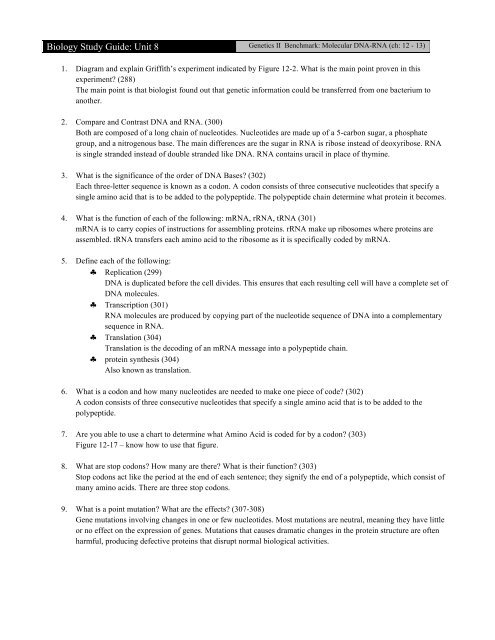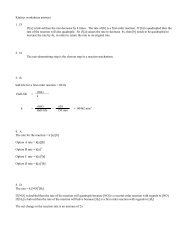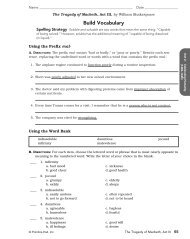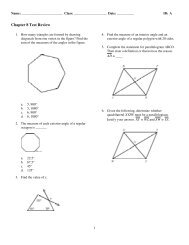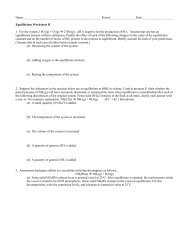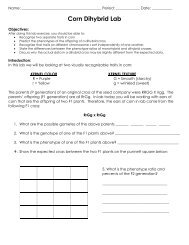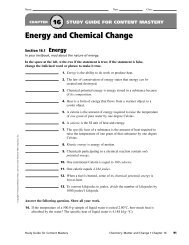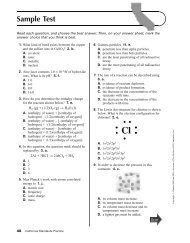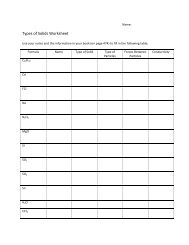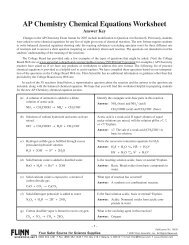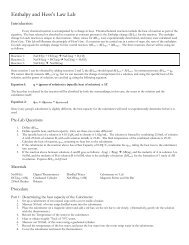Biology Study Guide: Unit 8
Biology Study Guide: Unit 8
Biology Study Guide: Unit 8
Create successful ePaper yourself
Turn your PDF publications into a flip-book with our unique Google optimized e-Paper software.
<strong>Biology</strong> <strong>Study</strong> <strong>Guide</strong>: <strong>Unit</strong> 8 Genetics II Benchmark: Molecular DNA-RNA (ch: 12 - 13)<br />
1. Diagram and explain Griffith’s experiment indicated by Figure 12-2. What is the main point proven in this<br />
experiment? (288)<br />
The main point is that biologist found out that genetic information could be transferred from one bacterium to<br />
another.<br />
2. Compare and Contrast DNA and RNA. (300)<br />
Both are composed of a long chain of nucleotides. Nucleotides are made up of a 5-carbon sugar, a phosphate<br />
group, and a nitrogenous base. The main differences are the sugar in RNA is ribose instead of deoxyribose. RNA<br />
is single stranded instead of double stranded like DNA. RNA contains uracil in place of thymine.<br />
3. What is the significance of the order of DNA Bases? (302)<br />
Each three-letter sequence is known as a codon. A codon consists of three consecutive nucleotides that specify a<br />
single amino acid that is to be added to the polypeptide. The polypeptide chain determine what protein it becomes.<br />
4. What is the function of each of the following: mRNA, rRNA, tRNA (301)<br />
mRNA is to carry copies of instructions for assembling proteins. rRNA make up ribosomes where proteins are<br />
assembled. tRNA transfers each amino acid to the ribosome as it is specifically coded by mRNA.<br />
5. Define each of the following:<br />
♣ Replication (299)<br />
DNA is duplicated before the cell divides. This ensures that each resulting cell will have a complete set of<br />
DNA molecules.<br />
♣ Transcription (301)<br />
RNA molecules are produced by copying part of the nucleotide sequence of DNA into a complementary<br />
sequence in RNA.<br />
♣ Translation (304)<br />
Translation is the decoding of an mRNA message into a polypeptide chain.<br />
♣ protein synthesis (304)<br />
Also known as translation.<br />
6. What is a codon and how many nucleotides are needed to make one piece of code? (302)<br />
A codon consists of three consecutive nucleotides that specify a single amino acid that is to be added to the<br />
polypeptide.<br />
7. Are you able to use a chart to determine what Amino Acid is coded for by a codon? (303)<br />
Figure 12-17 – know how to use that figure.<br />
8. What are stop codons? How many are there? What is their function? (303)<br />
Stop codons act like the period at the end of each sentence; they signify the end of a polypeptide, which consist of<br />
many amino acids. There are three stop codons.<br />
9. What is a point mutation? What are the effects? (307-308)<br />
Gene mutations involving changes in one or few nucleotides. Most mutations are neutral, meaning they have little<br />
or no effect on the expression of genes. Mutations that causes dramatic changes in the protein structure are often<br />
harmful, producing defective proteins that disrupt normal biological activities.
<strong>Biology</strong> <strong>Study</strong> <strong>Guide</strong>: <strong>Unit</strong> 8 Genetics II Benchmark: Molecular DNA-RNA (ch: 12 - 13)<br />
10. What is a gene? How does a gene mutation effect the protein coded for? (265, 307-308)<br />
The chemical factor that determines traits is called genes. Sometimes there is no effect at all, other times the effect<br />
will be harmful to the individual, creating defective proteins that disrupt normal activity.<br />
11. What is a frame shift mutation? (307)<br />
When a nucleotide is added or deleted, the bases are still read in groups of three but now those groupings are<br />
shifted for every codon that follows.<br />
12. What is meant by gene expression? (309)<br />
An expressed gene is a gene that is transcribed into RNA.<br />
13. What is meant by differentiation? (312)<br />
Differentiation is the specialization of cells during embryonic development to become more specialized in<br />
structure and function.<br />
14. What impact does the regulation of gene expression have on the cells in your body? (310-311)<br />
Cells turn their genes on and off as needed, by the use of enhancer sequences and repressor proteins. There are<br />
also start and stop codons.<br />
15. What makes proteins different? (302)<br />
Proteins are made by joining amino acids into long chains called polypeptides. Each polypeptide contains a<br />
combination of the 20 different amino acids. The properties of proteins are determined by the order which<br />
different amino acids are joined together.<br />
16. What determines the proteins shape and what does the shape determine? (302)<br />
The sequence of amino acids determines the proteins shape. The shape determines the function for the proteins.<br />
17. Read about Cystic Fibrosis, page 346 and Fig 14-8 page 347. What effect does the mutation have on the CFTR<br />
protein? (347)<br />
The deletion of one amino acid causes the protein to be destroyed before reaching the cell membrane and failing to<br />
regulate the chloride ion channels.<br />
18. What is the function of each of the following?<br />
♣ DNA Polymerase (299) It joins individual nucleotides together to produce a DNA molecule and also<br />
“Proofreads” each new DNA strand.<br />
♣ RNA Polymerase (301) It binds to DNA and separates the DNA strands. It then uses one strand of DNA as a<br />
template from which nucleotides are assembled into a strand of RNA.<br />
19. What are the base pairing rules for DNA and RNA? (294, 302)<br />
In DNA, adenine pairs with Thymine and Cytosine pairs with Guanine. In RNA Thymine is replaced by Uracil<br />
20. What is genetic engineering? What are the benefits to humans? (322,331-333)<br />
Genetic engineering is making changes in the DNA code. The benefits<br />
21. What are transgenic organisms? How are they developed? (331)<br />
Transgenic organisms contains genes from other organisms. By the process of genetic engineering a gene from<br />
another organism is isolated and inserted into the organism.
<strong>Biology</strong> <strong>Study</strong> <strong>Guide</strong>: <strong>Unit</strong> 8 Genetics II Benchmark: Molecular DNA-RNA (ch: 12 - 13)<br />
22. What is the significance of transgenic rice that contains vitamin A? (333)<br />
Rice is the major food for billions of humans. Vitamin A is a nutrient essential to human health. Therefore the rice<br />
may improve the diets and health of many people.<br />
23. Diagram and explain how to clone a mammal, page 332 Figure 13-13. (332)<br />
Take a donor cell from a mammal and a donor egg from another mammal. Fuse the two eggs by using electric<br />
shock. Take the fused eggs and let it develop into an embryo. The embryo is then placed into the uterus of another<br />
mammal to develop into a fully grown mammal.<br />
24. What happens to proteins when they are heated? (notes)<br />
(Changes the Shape of the protein)<br />
25. What are plasmids? (327-328)<br />
The foreign DNA is joined to a small circular DNA known as a plasmid.<br />
26. How is Bacterial Transformation used to create human growth hormone? (327)<br />
Gene for human growth is isolated and cut by using Recombinant DNA. That gene is inserted into a bacterial<br />
DNA, which is then inserted into the bacteria and allowed to reproduce in the bacteria.<br />
27. Define the following chromosomal mutations: (308, Figure 12-21)<br />
♣ Inversion – reverse the direction of parts of a chromosome.<br />
♣ Translocation – part of one chromosome breaks off and attaches to another.<br />
♣ Deletion – involve the loss of all or part of a chromosome.<br />
♣ Duplication – produces extra copies of parts of a chromosome.


